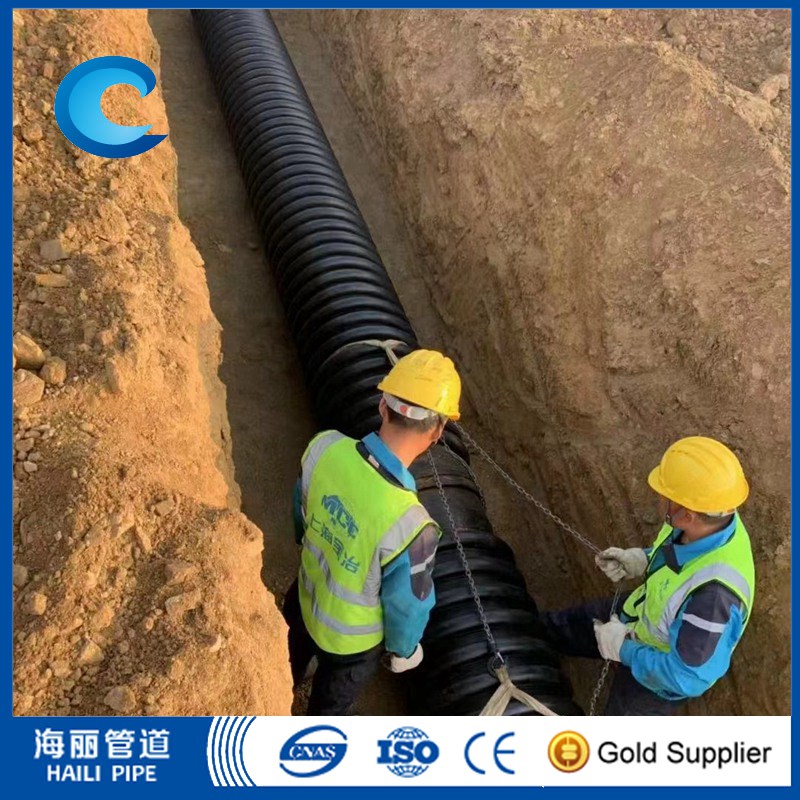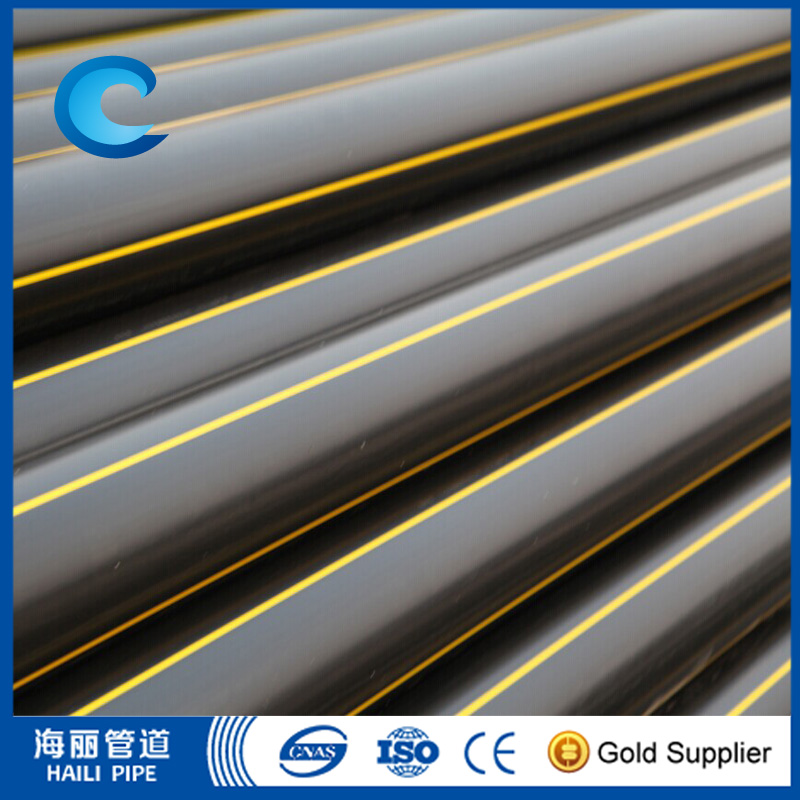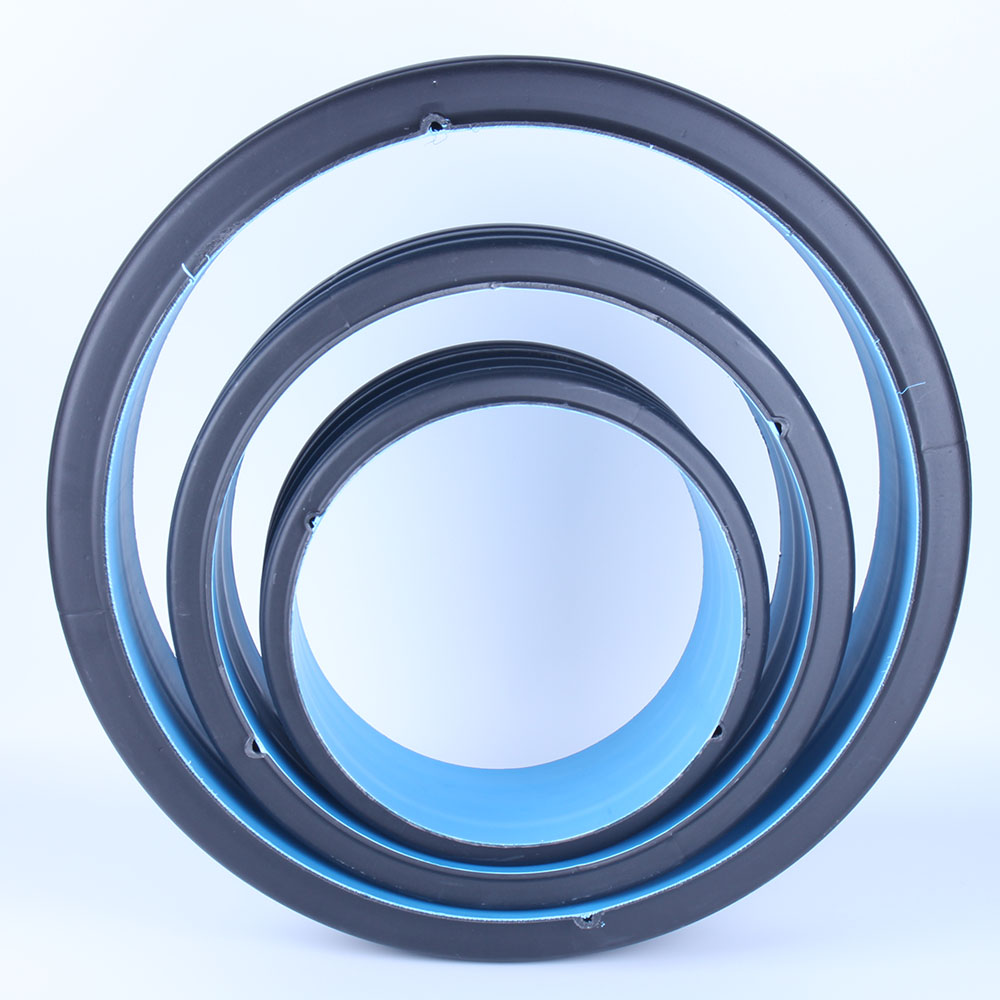installation of PE pipes
1). Installation of PE pipes
1. Before installation, check whether the pipe groove meets the installation requirements, and then check whether the appearance of the pipe has obvious dents, cracks, abrasions, scratches, and replace it immediately if there are hidden dangers in quality and safety.
2. C20 concrete is used to set concrete supports at pipeline elbows, tees, reduced joints, fire hydrants, etc., and flanged valves are reinforced with brick support structures.
3. When connecting PE water supply pipes with metal pipes, valves and fire hydrants, be sure to use steel-plastic transition joints or professional flange connections.
4. An exhaust valve should be set at the protruding position of the pipeline or on the uphill section to reduce the impact of the mixed pressure of air and water on the pipeline. The ratio of pipeline to exhaust valve is designed to be 1:8.
5. Because the PE pipe itself has good flexibility and elasticity, all pipe installations do not consider the installation of expansion joints.
2). Backfill compaction
After the installation and laying of the pipeline is completed, after the completion and acceptance of the concealed project, the soil should be backfilled immediately. The backfill should meet the following requirements:
1. Avoid the water in the tank causing the pipeline to float. If there is water, try to empty it.
2. When backfilling the pipe grooves in the stonework and earth-rock mixed areas, firstly transport the clay or sand backfill to 200-300mm from the top of the pipe, and then backfill other miscellaneous soils after compaction.
3. Backfill soil must be backfilled from both sides of the pipe at the same time, and the backfill soil should be compacted one layer at a time.
4. Before the pressure test of the pipeline, the backfill soil is usually not suitable for less than 500mm.
5. The large-scale backfill after the pipeline pressure test should be carried out in the condition that the pipeline is not suitable for water, and it is not suitable for the long-term empty pipeline after the pipeline is laid.

Skills for excavating PE water supply pipe grooves
PE water supply pipe has the advantages of light weight, convenient construction, smooth pipe, good hydropower standard, no fouling, corrosion resistance, long service life and so on. However, the plastic water supply pipe itself has defects such as high brittleness, impact resistance, and low resistance to mechanical equipment damage. Next, I will tell you about the way of excavating the PE water supply pipe groove.
1. The pipe trench should be excavated in a straight line, and the excavation width at the bottom of the trench is DN+0.30m. When the pipes are connected underground, the width of the trench bottom at the connection should be increased as much as possible. The width of the bottom of the pipe groove is not less than DN+0.50m, which is conducive to the installation and connection.
2. When laying the pipeline, the minimum depth of the topsoil soil layer should be considered as follows:
①When paving under the roadway, it should not be lower than 0.80m.
②When buried under the pedestrian crossing, it should not be lower than 0.60m.
3. When the crossing lane cannot reach the design depth, measures should be taken to pave the steel casing for maintenance.
4. When the pipe groove must be rotated, the rotation angle should not be too large, and the bending radius should meet the following requirements:
The allowable bending radius of PE water supply pipe R (mm) D≤5030D; 50D≤16050D; 160D≤25075D; D>250100D.
5. When manpower digs pipe trenches, the bottom of the trench must be level and compact, and there should be no sharp objects. The bottom of the canal can fluctuate, but the pipe must be stable at the support point. If there is a deep excavation situation, be sure to backfill and compact.
With the expansion of the scale of house operation, most of the pipelines are installed in the underground places, and the wall grooves are very easy to hide, which is beneficial to the actual operation, decoration, destruction and other work. Pipeline water tightness test is a reasonable way to avoid water seepage in the pipeline. The way of excavating the PE water supply pipe groove can reasonably maintain the water pipe.

What are the problems with PE pipes?
Nowadays, PE pipe has high-quality corrosion resistance, because it has many characteristics and advantages, and the usage rate is more and more common, so that it can be used better. Let's master the various problems in the processing process of PE pipe.
The corrugation on the surface of the PE pipe is due to insufficient cooling and unsuitable sealing ring specifications, resulting in vibration. It can improve the water inlet flow of the sizing sleeve or the distance between the lifting port and the sizing sleeve. Check whether the size of the sealing ring of the vacuum tank is small. If it is small, replace or moderately reduce the vacuum degree of one vacuum tank and increase the vacuum degree of the second vacuum tank. The pitting on the inner surface of the PE pipe is caused by residues in the raw materials, the inner wall between the mouth and the core is not cleaned cleanly, and the temperature of some parts is too high, resulting in aging. You can check the raw materials, clean up or transition for a while, check the temperature sensor. The surface dents of the PE pipe are due to the raw material damp, the bubble cracking, and the uneven water flow of the sizing sleeve. It can air-dry the raw materials, adjust the water flow or replace the sizing sleeve. The bright spot on the surface of the PE pipe is that the water flow of the sizing sleeve is not enough, which can increase the water flow of the sizing sleeve or replace the sizing sleeve with a large water flow.
The inner and outer walls of the PE pipe are not smooth radially because the moisture content of the raw material is too high, and the raw material needs to be air-dried. The surface of the PE pipe is not bright because the melt temperature is not suitable or the raw material is not very good, and the melt temperature can be adjusted or the raw material can be replaced. Scratches on the outer surface of the PE pipe may be caused by sand and gravel attached to the sizing sleeve, support plate or sealing ring, which can remove the sizing sleeve, support plate or sealing ring. The water line of the outer layer of the PE pipe is due to the blockage of some water holes of the sizing sleeve, resulting in excessive water flow in some water holes, which can remove the sizing sleeve.
221323.jpg)
The inner wall grooves of PE pipes mostly occur in thick-walled pipes. Because the wall thickness is too thick, the melt cannot be cooled, resulting in fluidity. The central cooling system can be tried to reduce the temperature of the mouth and core. The uneven wall thickness of the PE pipe is due to the loosening of the bolts of the mouth or core, the unsuitable adjustment of the gap between the mouth and the mouth, the uneven temperature of the mouth or the core, resulting in inconsistent material flow, misalignment between the sizing sleeve and the mouth, and spiral separation Shuttle or screen blocked. You can tighten the bolts or adjust the gap of the mouth, check the heating coil and temperature sensor, adjust the sizing sleeve and the mouth to fold the shuttle or screen. The low elongation at break of the PE pipe is due to the poor plasticization of raw materials, the improvement of orientation, and the improvement of cleanliness, which can adjust the process temperature, improve the actual effect of melting, and improve the distance between the mouth and the sizing sleeve. The large ovality of the PE pipe is due to the effect of gravity, which can improve the calibration equipment.
The above are various problems in the processing of PE pipes. Because of their unique advantages and characteristics, they are widely used. However, the whole process of engineering construction must be strictly carried out in accordance with the operational requirements to achieve good practical results and prevent redundant products. Inconvenience causes damage.









659.webp)
210.webp)
328.webp)

294.webp)
476.webp)


